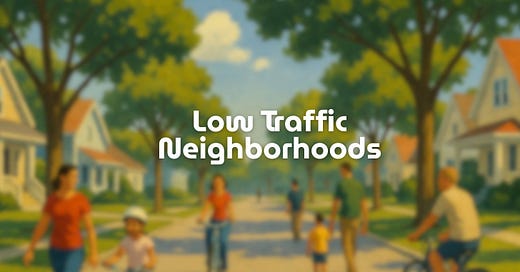How to make cars disappear without banning them
"Low traffic, high impact" is the UK’s blueprint for better neighborhoods
Magical things happen when walking and cycling are safe and convenient. Here’s what happened in some communities in the UK:
✅ 51% drop in vehicle traffic inside the neighborhoods.
✅ Over 2-3 years, 20% reduction in car use.
✅ No delays in emergency response times.
✅ Oxford: public support was 5-to-1.
✅ Britain: public support was 6.5-to-1.
✅ People are opting out of driving for their short trips. Walking increased 115 minutes per week; cycling increased 20 minutes per week.
In the UK, a Low Traffic Neighborhood (LTN) is what we in the US might call network traffic calming.
Here’s the idea: if you’re walking or riding a bike, you get the most direct, pleasant route through a neighborhood. If you’re driving, your path is more circuitous because some routes are off limits to motor vehicles. That’s it. LTNs don't ban cars, they just make the path of least resistance favor feet and pedals instead of horsepower.
In Cowley, a suburb of Oxford, LTNs led to a 51% drop in vehicle traffic inside the neighborhood. On surrounding roads, they saw a minor 3% average increase. Motor vehicle traffic evaporated, not because people stayed home, but because it was more convenient to walk or ride a bike for short trips.
Zooming out, an analysis of 46 LTNs across the UK found motor vehicle traffic dropped by an average of 47% inside the neighborhoods, while boundary roads saw a near-negligible 0.7% increase.
Not just fewer cars—but less driving overall. One study found a 20% drop in car use over just 2-3 years. People started walking 115 more minutes per week and cycling 20 minutes more. That’s some impressive behavior change.
“But what about the fire trucks?!” Emergency response times in Oxford stayed just as fast. But if safety is your concern, then you’ll be pleased to hear that in Oxford, traffic fatalities fell by nearly half. In London, pedestrian injuries in LTNs dropped by 85%.
“Ok, but do people like it when cars have to take a longer route and walking/cycling is giving preferential treatment?”
The short answer: yes. The longer answer: yes, and in huge numbers. Public support for LTNs in Oxford ran 5-to-1 in favor. Nationwide it was 6.5-to-1. Even in places where the rollouts had hiccups (some launched fast during pandemic lockdowns), surveys still showed people preferred their newly quiet, kid-friendly streets to the noisy chaos of the before times.
The usual critique is that LTNs push traffic (and pollution) to the edge of a neighborhood. While it sounds plausible, the data doesn't agree. That 0.7% average increase on boundary roads is statistically negligible, and certainly not the monster critics feared. Some of that traffic doesn’t relocate—it vanishes. It turns into walking, biking, and bus riding. The fancy term is "traffic evaporation."
Change is uncomfortable. And traffic engineers have spent decades optimizing cities for driving everywhere, no matter how short those trip distances might be. Reclaiming space for people instead of machines means detours and a few grumpy motorists, but the tradeoff is profound: safer streets, quieter streets, and healthier residents.




